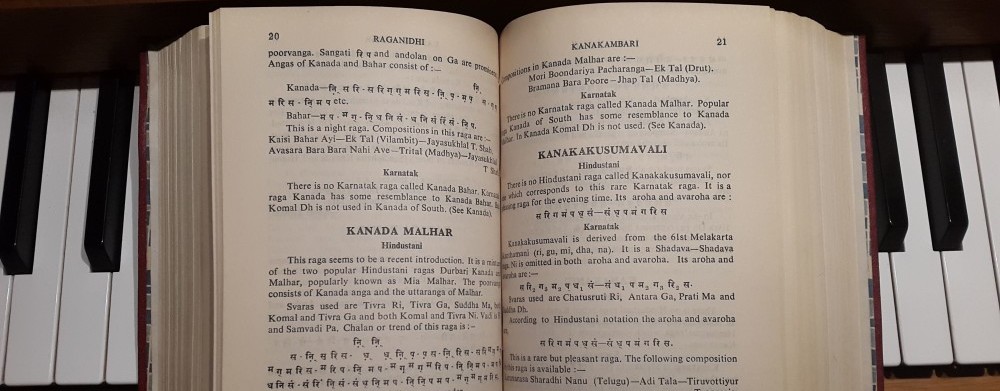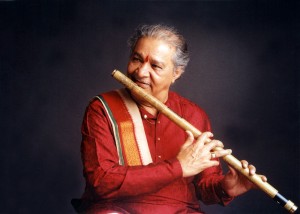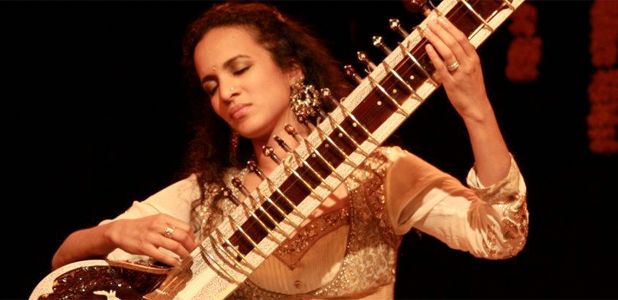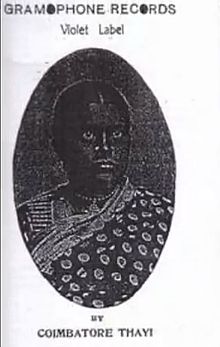I like to share this presentation of carnatic songs by legendary singer Damal Krishna Pattamal
The songs: 1. Entharani 2. Datsukovalena 3.Sari Evvare 4.Parthasaradhi 5. Nan Oru Vilayattu Bommaiyiah 6. Mapala
It’s DKP at her best! Enjoy!

I like to share this presentation of carnatic songs by legendary singer Damal Krishna Pattamal
The songs: 1. Entharani 2. Datsukovalena 3.Sari Evvare 4.Parthasaradhi 5. Nan Oru Vilayattu Bommaiyiah 6. Mapala
It’s DKP at her best! Enjoy!
Playing around India – A portrait of Dutch cellist Saskia Rao-de Haas, is a radio documentary I produced in 2002. [original Dutch title: Op streek in India – een portret van de Nederlandse celliste Saskia Rao-de Haas]
The documentary is mostly in dutch, but this video offers a transcript in english locked to the timetable, in order to make this production accessible for an international audience. To allow convenient reading of this transcript, you should play the video in HD (1080p).
Production date: May-June 2002. First broadcast by Concertzender on 8 November 2002, also broadcast by Radio Netherlands on 25 and 29 December 2002. Voice narrator: Wim Vriezen.
In the documentary ‘Playing around India’ (produced May-June 2002) programme maker Pieter de Rooij introduces the career of the brilliant 31-year-old (that is, in 2002) cellist Saskia Rao-de Haas. She is one of the very few people, and the only European, to play the classical ragas of North India on the cello. She is considered the only genuine cello soloist by the Indian concert going public. Her virtuosity and deep musicality have introduced a new resonance to Indian music and have been enthusiastically receieved by critics and audiences worldwide. To achieve a proper Indian sound Saskia Rao-de Haas plays on a specially modified cello: smaller (so as to be able to be played sitting on the floor), with five instead of the usual four strings, and with ten ‘sympathetic’ strings. These freely resonating strings give a beautiful Indian sound to the cello and the instrument has quickly become very popular.
For two years (speaking from 2002) Saskia Rao-de Haas has lived in New Delhi with her husband, the famous Indian sitar player Shubhendra Rao. As well as traditional raga improvisations, she and her husband play their own compositions in which they mix classical Indian music with elements from European folkmusic and Western classical music.
In May and June 2002 Saskia and Shubhendra toured outside India when, for the first time, Western audiences were able to hear the combination of sitar and cello in Indian classical music. Programme maker Pieter de Rooij caught up with the couple in Amsterdam where they gave a concert at the KIT Tropen Theatre on 25 May. Saskia talks about her music, her cello and her life in India. Her husband Shubhendra, the violin maker Eduard van Tongeren and her former teacher at the Rotterdam Conservatory, Joep Bor, all have something to say about Saskia’s amazing cello adventure. Recordings from the Amsterdam concert are heard during the documentary.
I came across some very interesting documentaries concerned with various aspects of Indian classical music.
SaReGa, produced in 2010 and directed by Valerie Berteau, is a film introducing Hindustani music. Musical notes have the power to affect and enhance our feelings. The Hindi/Urdu word “rag” means color, or passion. Therefore, a raga can be defined as an accoustic method of coloring the mind of the listener with emotion. For centuries, its oral transmission has maintained the essential qualities of this remarkable tradition.
Koi Sunta Hai (Someone is Listening): Journeys with Kumar & Kabir, was produced in 2008 and directed by director Shabnam Virmani. This film interweaves the poetry of North Indian 15th century mystic poet Kabir with the life and music of the late Indian classical singer Kumar Gandharva.
Man of Collection, produced in 2008 and directed by Mohani Bhoj, tries to document the journey of a man who has spent 35 years of his life putting together the golden age of Hindi cinema that has nearly got erased from our collective memories. The journey of musical greats like Anil Biswas, Khemchandra Prakash, Naushad and musical renditions of classical ragas like daadra, dhrupad, thumari, ghazals, bhajans by great singers and compositions of various musicians is the wealth of this one man Pritam T. Manghani. From the first record to be made in India (singer Gauhar Jahan’s) to the last lp of hindi films (Veer-Zaara), from classical music to folk songs in any language, to advertisements in old records, to speeches of political figures like Mahatma Gandhi, Netaji Subhash Chandra Bose to recitations of great poets like gurudev rabindranath Tagore, india’s nightangle Sarojini Naidu, the revolutionary poet kavi kazi nazrul islam etc. Other than collecting gems from the world of sound, Pritamji is a proud owner of old film magazines, pamphlets & posters. But what he likes most from his treasure is the Edison collection. Looking at Edison’s laboratory record he says ” Without Edison we wouldn’t have experienced the world of sound”.
Sound Yoga/Nada Yoga: The Healing Power of Sacred Sound was produced in 2004 and directed by Jay Weidner. Teacher, vocalist and sound healer Shanti Shivani introduces the mystic practice of Nada Yoga. Nada Yoga is the core of Dhrupad, the most ancient style of Hindustani classical music.
Not to be missed on Sunday 26 May 2013! A double concert in De Meervaart in Amsterdam to celebrate the 75th birthday of bansuri maestro Pandit Hariprasad Chaurasia.

Pandit Hariprasad Chaurasia
The programme of the celebration concert:
Concert 1 14.30-16.00
Meeta Pandit, vocal ; Sandip Bhattacharya, tabla ; Rafiq Ahmed, sarangi ; Rohit Vyas and Martin Spaink, tanpura.
Concert 2 16.30-18.00
Pandit Hariprasad Chaurasia, bansuri/bamboo flute ; Subhankar Banerjee, tabla ; Stephanie Bosch, tanpura.
Tickets for the concert in Amsterdam on Sunday 26 May can be booked online via http://www.meervaart.nl/ Price for a ticket is € 26.
_____________________________________________________
A beautiful recording, Hariprasad Chaurasia plays Raag Malkauns
A promo for ‘Bansuri Guru’ (2013), a film highlighting
life and career of Pandit Hariprasad Chaurasia
The rough translation of the song:
“This is the story of a girl, restless in thought, who wants to take the road less traveled. A girl who refuses to let her feet touch the ground and desires independence from the path that was chosen for her. She packs her belongings and wants to fly, away from her constraints and bonds. She wants to let her thoughts fly with her through a path like the one a kite takes in the wind. On her journey, she sees the world shimmering with color and all things living, dancing and singing to the tune of freedom.”
On 23 April 2006 I filmed Kala Ramnath’s concert at RASA in Utrecht/The Netherlands. Since then I published a lot of this concert in separate parts. Finally I’ve now uploaded the complete concert on my YouTubechannel.
Kala Ramnath/violin; Satyajit Talwalkar/tabla; Celine Wadier/tanpura
00:00 – 57:48 Raag Madhuvanti
58:13 – 1:27:40 Raag Dinki Puriya
1:27:54 – 1:39:45 Composition in Raag Des
It’s great to be able now to play this fabulous concert in one go! (Yes, fans/admirers of Kala, you should really thank me for this upload 🙂 ) And for the first time you can now enjoy Kala’s complete Madhuvanti in this concert, which is a great bonus!

Despite the fact that flamenco, the fiery song and dance genre from Andalusia/Spain, is a well known genre all over the world, it’s still not common knowledge that the genre’s ancient roots lie in gypsy music from Rajashtan/India. A great and awarded album exploring this India-flamenco connection is Traveller by renowned sitar player Anoushka Shankar. On this album – I quote from her website – “she finds her way into the nuances of modern flamenco through the vivid lens of Hindustani technique. In essence, Traveller charts the spiritual link across time and space of two highly evolved forms of musical expression, from their ancient gestation to their modern zenith.” On her homepage Anoushka Shankar adds: “I’ve always loved flamenco and had a fascination for it. There’s always been that pull towards something I find very similar in flamenco to what I cherish in Indian classical music: a kind of uninhibited musicality in expression, whether it’s a solo voice, a sitar or a guitar. Of course there were common roots and technical similarities to explore, and when you start to play with those, you can really delve down in very delicious ways. However the desire came from simply being an admirer of the music, and wanting to learn about it through making music.”
The album release in 2011 was followed by a world tour, and from this tour the inspiring and well recorded concert below is a joy for watching and listening. So, without further ado, enjoy the great musicianship and temperament of Anoushka Shankar and her fellow travellers on stage!
Anoushka Shankar’s Traveller concert at Festival Les Nuits de Fourviere (Lyon/France), July 13th, 2012

I came across an interesting article by Subha J. Rao in The Hindu about one of the first and most popular recorded female carnatic singers: Coimbatore Thayi (1872-1917). In the article, author-biographer Vikram Sampath tells about his work on reviving Coimbatore Thayi’s legacy as part of a book on female singers.
The British Gramophone Company set foot in South India in 1904 and started recording many artists, among them Coimbatore Thayi, who was one of the most popular singers in Madras. Thayi became a bestselling artist, but she died young – in her mid-forties – in 1917. On approximately 300 discs, “she recorded” – writes Rao – “a rich repertoire of songs, including the compositions of Tyagaraja, Shyama Sastri and Dikshithar, padams, javalis, the Thirupugazh… Sadly, most of them are lost to time. However, some of them can be heard on YouTube and Vikram’s Archive of Indian Music.”
The article in The Hindu takes an interesting turn when the story of Thayi moves to Europe: “She was popular abroad too. In 1911, a French musician Maurice Delage heard her soft, bhakti-filled voice in Paris and was smitten. He wrote to his teacher, Maurice Ravel, about her microtonal effects and variations (gamakas) and voice. “It sent chills up and down my spine”, he wrote. He met Thayi in Madras and even composed two sets of Western music pieces— Quatre Poèmes Hindous, one each dedicated to the cities of Madras, Banaras, Lahore and Jaipur; and a Ragamalika said to be inspired by Thayi’s rendering of an arutpa.”
Martha Angelici sings Maurice Delage’s Quatre Poèmes Hindous
Janet Baker sings Maurice Delage’s Quatre Poèmes Hindous
Today there are some recordings and photos left of Coimbatore Thayi, though very little is known of what her life was like and how she spend her childhood.
Biographer Vikram Sampath summarizes: “Thanks to some existing recordings, we know that she sang her heart out into the horn. And that she had a voice which touched a chord even in faraway Paris.”
Maati Baani is a group from India centred around Nirali Kartik, a Hindustani classical trained singer. As stated on Facebook Maati Baani is “a world music band combining elements of Hindustani Classical with various styles of Folk music and New age sounds; we are like mad people set loose!! No rules, no boundaries, we simply create the sound that we love to hear with our different styles of music.” Influences they mention are: Michael Jackson, Pt. Jasraj, A.R. Rahman, Shankar Tucker, Indian Ocean, Jimi Hendrix, Pink Floyd, Sting, Ustad Rashid Khan, Jack Johnson, and Coldplay. The band has done some exciting and succesful collaborations with a.o. American clarinet player Shankar Tucker and with folk singer Mooralala Marwada. I just like to add one word to characterize Maati Baani: Fun! 🙂
What an amazing young talent, evry detail soo beautifully articulated. Listening to the rich sound of this rhythm queen is truly a listener’s delight. I think the Gundecha Brothers, on front row in the audience, will agree with me.